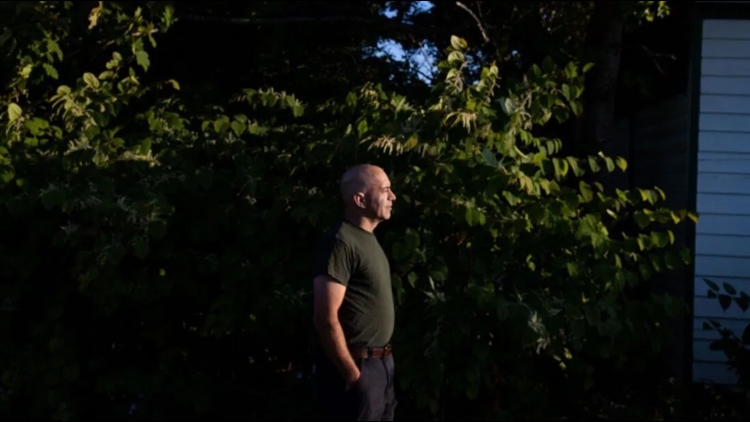BAR HARBOR, Maine — There’s a parcel of land in Northeast Harbor on the corner of Neighborhood and Manchester roads that Steve Anastasia has walked by for years.
It’s on the edge of the village, a short distance from the library and elementary school. Just down the way is Main Street, with its quaint shops, galleries and the Great Harbor Maritime Museum. In the summer, the sidewalks are full, families meandering with shopping bags and ice cream cones in hand. But in the winter, it’s a different scene.
“It’s desolate, it’s asleep,” Anastasia said. “It’s mothballed and put away.”
Anastasia, a maintenance worker for Acadia National Park, lives off Main Street in an apartment building owned by Mount Desert 365, a nonprofit whose mission is to combat “community deterioration” in the town of Mount Desert, which includes the village of Northeast Harbor.
Between 2012 and 2022, the town’s population shrunk by 20 percent while the seasonal vacancy rate — homes left empty by summer residents or houses converted into short-term rentals — grew from 46 to 60 percent. (Bar Harbor recently began regulating short-term rentals; the island’s three other towns have not.)
The median price for a home in Mount Desert last year was nearly a million dollars, doubling in just five years.
Mount Desert 365, watching these changes unfold, began purchasing property several years ago with hopes of building year-round workforce housing — typically property whose sale or rental price is lowered below market rates and set aside for people with incomes near the area median.
One of those plots is the 0.9-acre lot on the corner of Manchester and Neighborhood, where the group plans to build a six-unit subdivision called “Heel Way.”
The lot currently includes a columned cape and a five-bay garage in the back surrounded by maple and oak trees. When Anastasia stops and looks, he sees a potential permanent home for himself and his kids.
Anastasia moved to Mount Desert in 2013 with his then-wife and their two sons. They bought a house in a workforce development near the head of the island, built by another nonprofit, Island Housing Trust. Even then it was one of the few affordable options they could find.
Anastasia raised his kids there and built a wood-fired oven in the back, which he used to grow a small bread-baking business while his wife worked for the National Park Service. He served on volunteer boards and donated his bread to local fundraisers.
“I know what workforce housing looks like, and I know how remarkable it is to have year-round families with kids and neighbors that you can rely on next door to you,” Anastasia said. “There is no ability for anyone of normal middle-class means to live on this island any longer without the help of a workforce housing circumstance.”
He planned to expand his business into a brick-and-mortar bakery and cafe, but then came the pandemic and his divorce, and things changed.
Anastasia got a job with the National Park Service and is now one of the workers who ensures Acadia doesn’t decay under the weight of the more than 4 million visits it receives each year, visits that fuel the local recreation-based economy: hotels, campgrounds, restaurants, lobster pounds, and bike and kayak rentals. In the summer he puts new roofs on park buildings, fixes bathrooms and replaces fixtures. While many park workers leave the island during the winter, he stays on, rehabbing the interiors of park buildings.


During “the season,” which runs from May to October, cars and trucks pour over the bridge, carrying workers who make it possible for Mount Desert Island to serve as a summer haven for some of America’s richest people.
Come nightfall, those workers go back over the bridge, unable to find or afford housing on the island.
Anastasia gets to stay, but only because he found an apartment set aside for working-class people, and because he didn’t have pets and everyone in front of him on the waiting list did. He knows he’s lucky to have a place in town, but it’s a rental, and he dreams of one day buying a home and making it his own.
“I’m holding on for Heel Way,” Anastasia said. “But it’s not everybody’s dream to see housing there.”
Since the start, the project has been the subject of great debate, spurring petitions for and against. After months of public hearings, it was approved by the town planning board late last year in a 3-1 vote. But soon after, a group of seven wealthy summer residents sued the town, arguing the six-unit project was too dense.
A judge struck down all their arguments; undeterred, they appealed the court’s decision last month, delaying the project and costing the town, so far, at least $55,000 in legal fees. The Maine Supreme Judicial Court won’t hear the case until February at the earliest.
The project proponents say the island desperately needs housing and year-round residents, and the Heel Way subdivision would be an important, if small, step. Many see the lawsuit as an example of a NIMBY (“Not In My Backyard”) attitude that has limited housing development across the country.
Opponents, meanwhile, say they support workforce housing but think the Heel Way project is flawed, with too many units on too small a plot — out of character for the neighborhood.

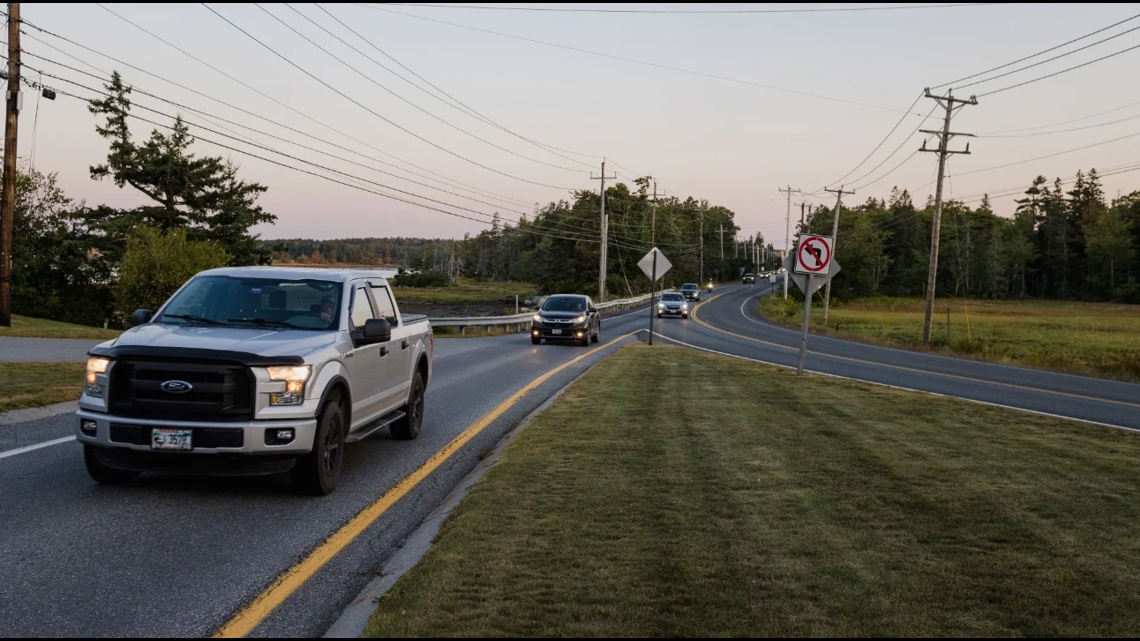
The debate comes amid a number of recent votes by Maine communities to stop affordable housing projects — distinct from workforce housing but with a similar goal — including a 107-unit proposal in Cumberland and a 45-unit project in Kingfield earlier this year.
What makes the fight over Heel Way unique is the small size of the project — just six units — and the way it has been stymied not by local voters but by a lawsuit from seven wealthy people who only live in the area part-time.
The debate pits millionaire summer residents not only against the town planning board, but against billionaire brothers Mitchell and Steven Rales, who have funded the effort to build housing for working-class people.
As Maine grapples with a housing shortage exacerbated by the pandemic, the fight over Heel Way shows how efforts to address the crisis can be both buoyed and stymied by the same force: private individuals with massive wealth.
A growing crisis
Across the United States, the refrain is the same: There isn’t enough housing. One recent analysis found that the U.S. is short 4.5 million homes, while Maine, a state study found, needs to build 84,000 homes by 2030 to make up its deficit.
One way to address the crisis, experts say, is by changing zoning laws, which often serve as a way for communities to forbid cheaper, denser housing in favor of single-family homes. Maine has taken steps to loosen zoning policies in recent years, including instituting a law in 2022 that required municipalities to adjust ordinances to allow greater density and accessory dwelling units on single-family lots.
Coupled with historic investments in affordable housing, Maine is moving in the right direction, said BJ McCollister, a lobbyist and policy director for the Maine Affordable Housing Coalition.
“We have seen the rapid development of affordable housing units,” McCollister said. “But unfortunately, sometimes there are communities that are finding new ways to block affordable housing.”
A 2018 study of Mount Desert Island’s housing needs found that, conservatively, there was demand for an extra 125 to 300 workforce housing units, and the island could “easily” absorb 100 to 200 below-market-rate senior housing units by 2023.
But for many who live and work on the island, the 2018 housing market seems like a different world. The pandemic exacerbated the trend of people converting year-round housing into summer homes and short-term rentals, taking housing off the market and driving up prices. The price of a median home in Mount Desert, according to the Maine State Housing Authority, was just under $450,000 in 2018. By 2023 it had doubled to $903,000.

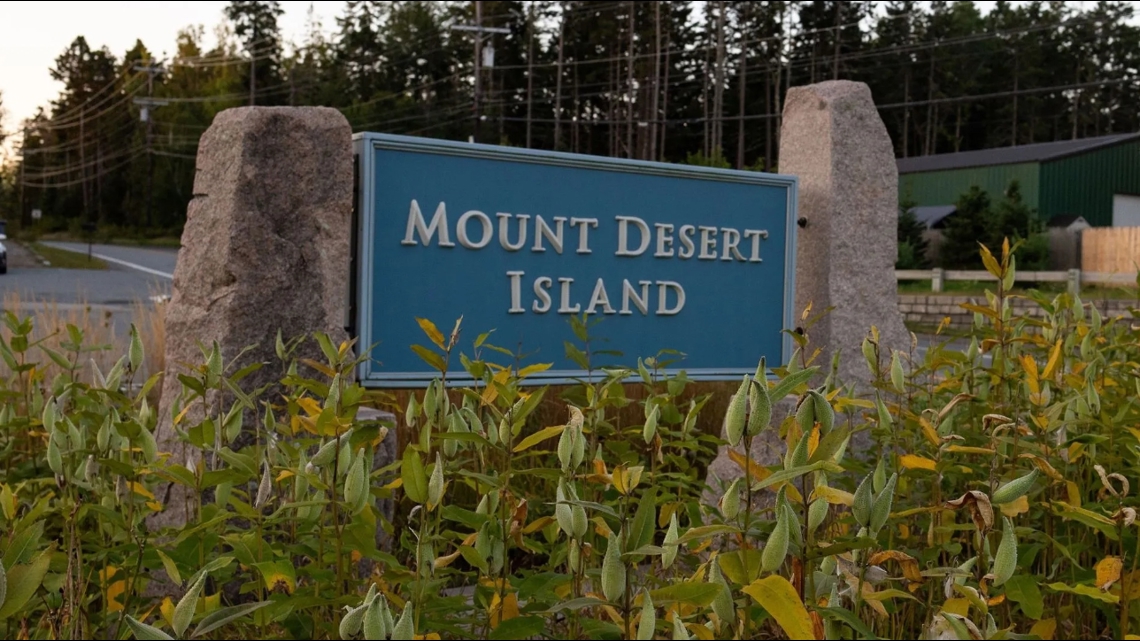
For many, the jump has put living in town out of reach.
In 2022, Amy Wisehart was hired as the director of the Northeast Harbor Library — a two-story, 25,000-square-foot facility that is 85 percent privately funded. She found a rental in town but it was just for the winter.
When summer’s peak-season rents forced her out, she stayed with a friend for a month, and began asking friends, acquaintances and library patrons if they had any housing leads. Then she started looking into borrowing an RV and living on a campground for the summer.
“It did feel a little hopeless,” Wisehart said.
She eventually found another rental, but as a single parent the cost wasn’t sustainable. So the library decided to do what many island organizations have done to attract and keep employees: They got into the housing business, purchasing a three-bedroom ranch in the village for a half-million dollars that would be the library director’s house moving forward.
It’s become common for businesses large and small on the island to provide, and sometimes build, housing for employees, adding costs to businesses that are sometimes only open half the year.
Earlier this year, Witham Family Hotels opened a three-story housing complex that will house 84 seasonal workers in Bar Harbor. The nonprofit Friends of Acadia has begun construction on housing for eight seasonal National Park Service workers in Seal Harbor, another village in the town of Mount Desert. (Last year about 30 percent of Acadia’s seasonal positions went unfulfilled, in large part because potential workers struggled to find a place to stay.)
Susan Allen, an island native who owns the Harbour Cottage Inn in Southwest Harbor, bought a house three doors from her own home to house four of her seasonal employees. In the winter she rents it to a friend.
“I don’t like taking any year-round housing out of stock,” Allen said. “But it’s a slippery slope because if I can’t get staff, I can’t run my business, and then I’d have to leave.”

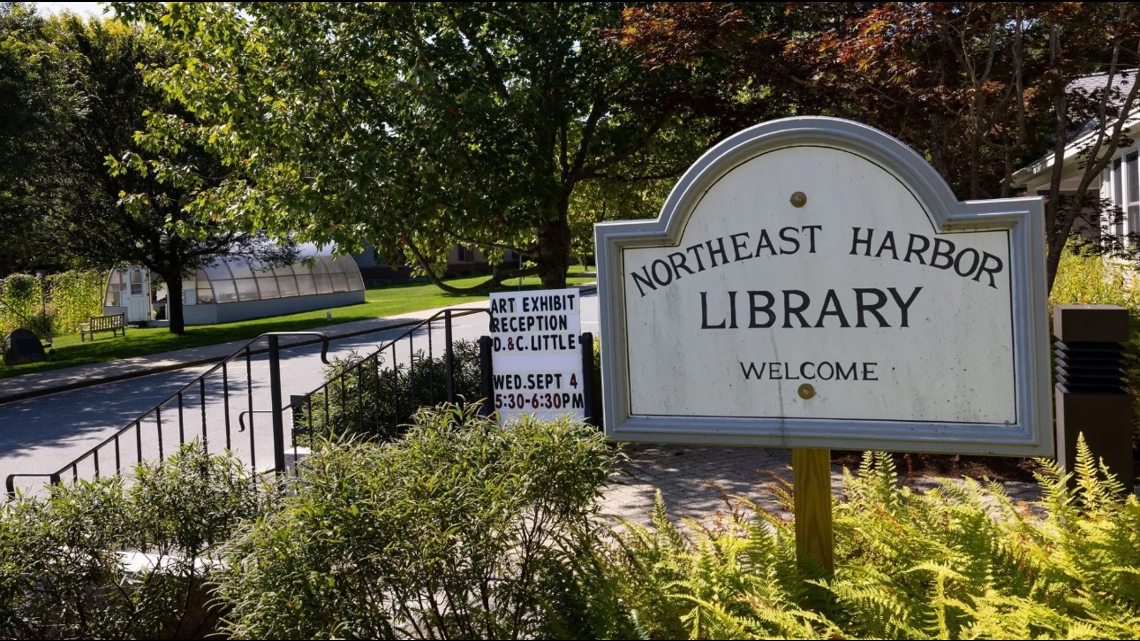
For Jackson Laboratory of Bar Harbor, the housing shortage represents an existential threat.
When Lon Cardon, the CEO of Jackson Laboratory, which employs 1,500 people in Bar Harbor, Ellsworth and Bangor, talked to a meeting of the Mount Desert Association of Summer Residents in Northeast Harbor last month, he described the integral role his lab’s research has played in fighting and treating diseases.
Then he turned to housing.
Cardon told them that when he took the job and moved to the island in November 2021, he couldn’t find a place to live. (Cardon earns more than $1 million a year at the lab, tax records show.)
“There was no housing at all available,” he said. He ended up in a board member’s guest house, but it wasn’t winterized. “I didn’t know the term ‘three-season,” Cardon said, provoking laughter. “I was ever appreciative of her guest house, but I was pleased not to do it again the next winter.” He eventually rented a house from one of the lab’s researchers.
The struggle is even greater for the lab’s rank and file. The laboratory built 24 rental units for its employees, which Cardon said didn’t move the needle. If he had been in charge at the time, he’s not sure he would have approved the project, he said. After all, building housing diverts money from research.
The question of housing prompts an even larger one for Cardon and his lab, the largest private employer on the island: “Do we stay here?”
‘This village has lost so much’
Mount Desert 365, the group behind the Heel Way project, started because of cruise ships.
Sitting in her office overlooking the harbor, executive director Kathy Miller recounted her group’s origins: In 2016, a relatively small cruise ship dropped anchor and disgorged vacationers into the town. Some saw this landfall as a portent of a future that revolved around selling tchotchkes to tourists. Meetings and debates followed. Eventually, the town of Mount Desert passed an ordinance that barred cruise ships from letting passengers disembark. Other towns on the island followed suit (except for Bar Harbor, where the battle rages on).
During those meetings, many business owners said the day the cruise ship came to town was their best in years. And so two things became clear, Miller recalled: This town doesn’t want cruise ships, but local businesses need more support to stay solvent. And the founders of Mount Desert 365 thought the best way to do that was to increase the year-round population.

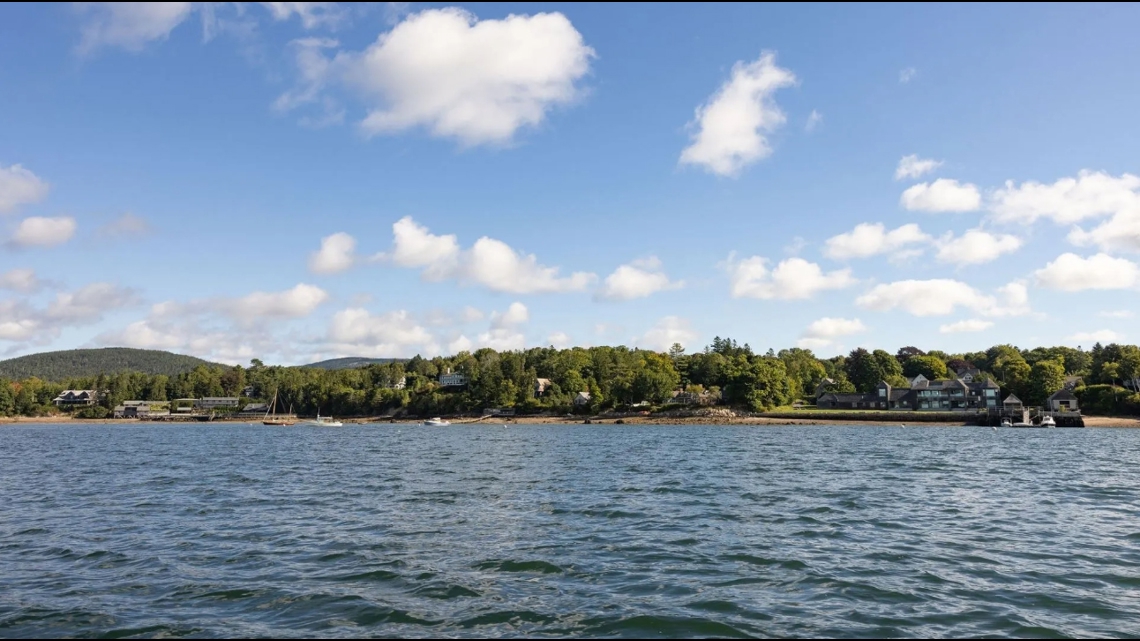
The founders included Mitchell and Steven Rales, the brothers who launched the Danaher corporation in 1984. The company is now a publicly traded “global life sciences and diagnostics innovator” worth $197 billion. The brothers, who have an estimated combined net worth of nearly $15 billion, own millions worth of property in the town of Mount Desert through various LLCs, including the $19 million dollar Rockefeller mansion that Mitchell Rales tore down and rebuilt.
Mount Desert 365 launched in 2017 with $6 million in funding, according to tax records. Shortly after, the group bought the Heel Way property, and eventually purchased nine others. By the end of 2023, the group owned $9.7 million in property but had just $131,197 in savings and cash, according to its most recent federal tax filings.
The final design for Heel Way, approved by the planning board, shows a lot with two duplexes, two single-family houses and a five-bay garage, which would be converted into storage space. Each unit has a two-car driveway and a deck.

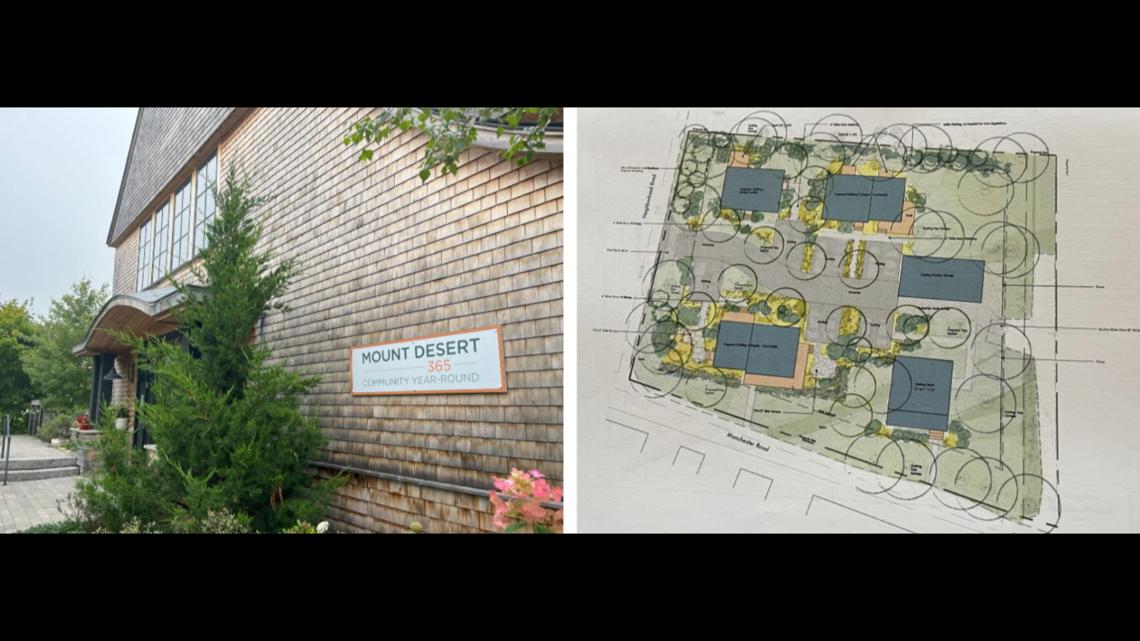
The original plan was for the houses to cost between $250,000 and $275,000 — around a quarter of the median price in town. But Miller notes that estimate is now years old, and the longer the project is delayed, the higher the price is likely to rise.
Units will be sold to families who qualify for mortgages but don’t make more than a certain percentage of Maine’s median income, depending on family size, Miller said. A family of four would be eligible if they earned less than 160 percent of Maine’s household median income of $73,733, which would be $118,000 a year.
The Heel Way renderings show small houses with columns and dormer windows, bracketed by lush trees and well-manicured hedges. One shows an adult holding a child’s hand as they approach a house. This is what proponents envision: young families with parents doing essential work and children attending the local school, a short walk away.

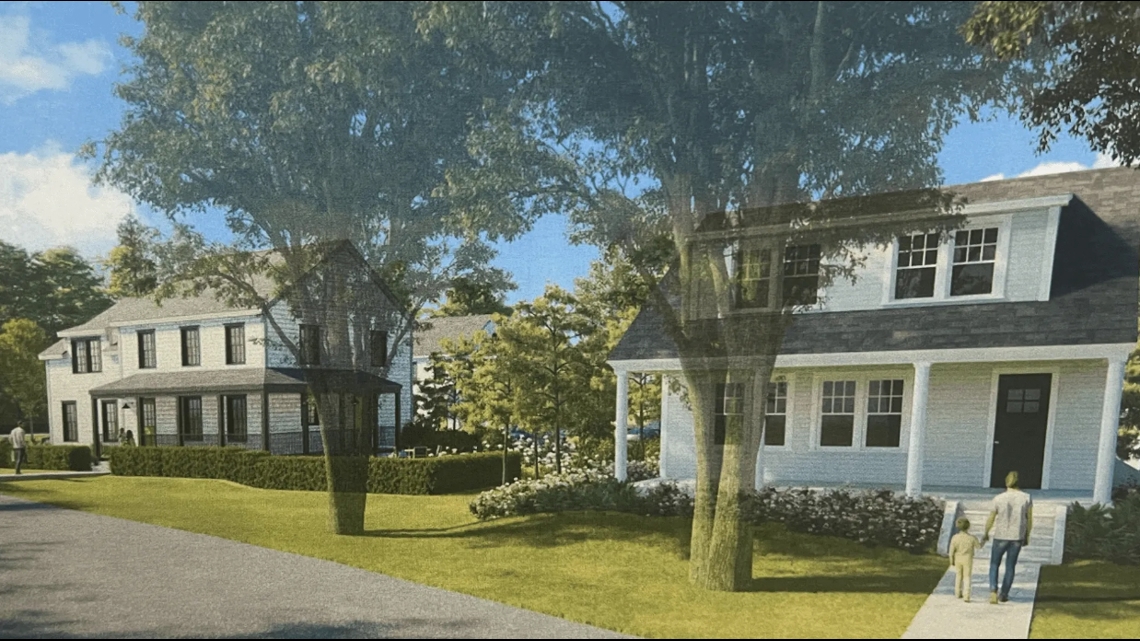
“This village has lost so much. This village used to be vibrant in the wintertime and now it’s dead,” Miller said.
“And if you don’t want shops that are boarded up all winter because there’s nobody there, then you’ve got to have people.”
‘Packed in so densely’
Opposition to the project has been fierce. In the fall of 2022, a petition was signed by 205 residents who “support workforce housing” but oppose the project. They argue the housing units would be too cramped, and warn about traffic that would hurt children riding their bikes between the tennis and yacht clubs.
They worry there wouldn’t be enough space for all the stuff that sits in Maine garages and sheds: grills, snowblowers and boats. They argue the character of the neighborhood would change, and residents wouldn’t be able to build equity because the sale to the next qualified buyer would be capped by price restrictions.
To many opponents, the main problem is the number of units. Under the old density ordinance, six units would not have been allowed on a lot the size of Heel Way. But under the updated ordinance, developers can use a “density bonus” if the area is designated as workforce housing.
Many said they’d have no problem with three units on the property. Why did it have to be six?
“The state needs as many as it can get,” Miller said. “Our mission is to bring back a more robust year-round population, and so we are working within the ordinances. We’re not asking for any special permission. This is what the ordinances allow. So why not do it?”
During one planning board meeting, Miller made a presentation showing there already were several other lots in the village with similar or greater housing density, calculations the planning board cited in its approval of the project.
In addition, a basic fact of housing construction is that greater density lowers costs.
“There is an economy of scale,” Miller said.


Barbara Ryerson, whose husband is one of the residents who sued the town, was involved in submitting the petition against the project. In a March 2023 letter to the planning board, she wrote that she and other neighbors had “put ourselves in the shoes of the residents” and had concerns: “We want to ensure the workers in Northeast Harbor and the town of Mount Desert are able to obtain affordable housing and live comfortably, safely, and not packed in so densely.”
But the density doesn’t bother Anastasia, nor Gloria Kunje, who for months traveled between her home in Connecticut and Bar Harbor while working at the College of the Atlantic because she couldn’t find a place to live on the island. Now a special education teacher living in the same Mount Desert 365 project as Anastasia, Kunje wonders how opponents came to their conclusions.
“That’s not an issue at all,” she said of the density. “When those arguments are made, are they actually asking the people who would love to live there?”
One common argument at public hearings, almost always prefaced with a declaration of support for workforce housing in general, was that tenants filling up six units could bring a dozen new cars to the corner, which sits on Manchester Road.
In one June meeting, Mara Lehrman, a summer neighbor on Manchester Road, noted her “primary concern” was the safety of children biking, asking if MD 365 shouldn’t focus its efforts on its property “where it would not disturb the wonderful independence that children have in Northeast Harbor to bike without the fear of getting hit by cars.”
Traffic engineer Diana Morabito shared the results of a traffic survey done by the Department of Transportation that found Manchester and Neighborhood roads had a peak of 84 vehicles per hour in busy July, with daily volumes ranging from 550 to 880 vehicles per day. Her study found that the site would add four to five more cars per hour.
“That’s one extra car coming or going every 12 to 15 minutes,” Morabito said. “That’s not a lot of additional traffic.”

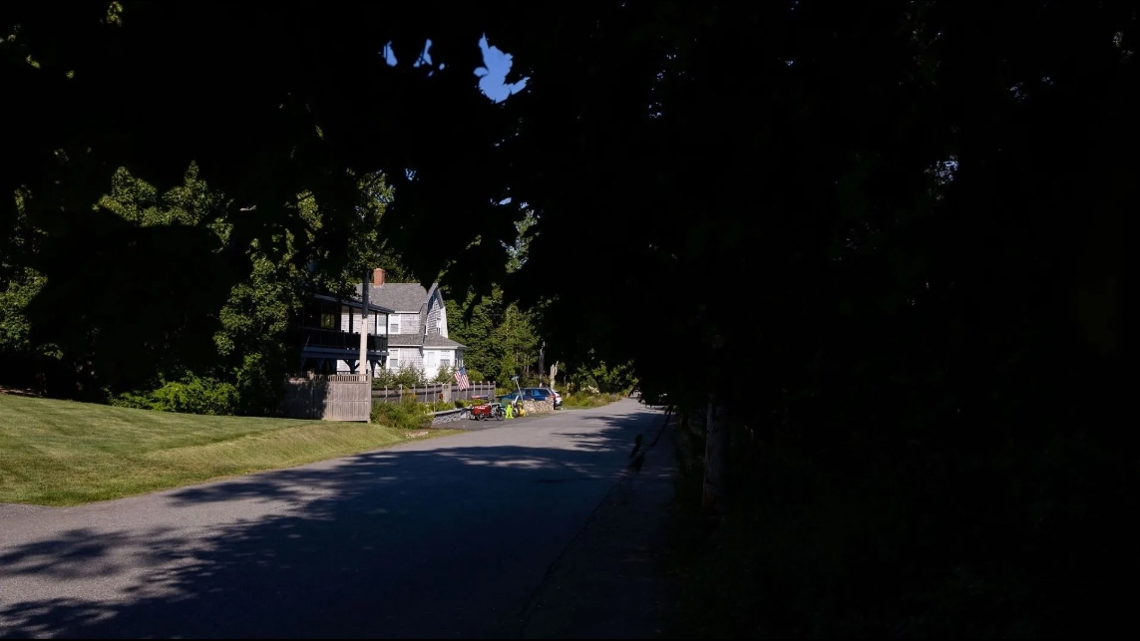
Proponents also noted that the project’s driveway exits onto Neighborhood Road, not Manchester Road, which is the road well-traveled by children.
In fact, Mount Desert 365 altered the plans in response to neighbor concerns, moving the driveway from its original spot on Manchester Road. Then they moved the driveway again so it wasn’t aligned with the driveway across the road, because the residents of that house — who lived there only part-time — were worried about headlights shining on their house at night.
Bill Hanley, an architect and chair of the Mount Desert Planning Board, said part of the controversy stemmed from Mount Desert 365’s “unwavering position” on the number of units.
“It’s a lot on a little,” he said, noting that putting that many units on a small lot in a “single-family residential area in the village of Northeast Harbor” is “going to stir up the hornet’s nest.”
Hanley was the one member of the four-member planning board who found the project did not meet the town’s criteria requiring “compatibility” with the surrounding area.
Meredith Randolph, a planning board member who resigned in July, said Mount Desert altered its designs a great deal in response to community feedback. In her opinion the planning board process worked — but it wasn’t enough.
“We got it back, redesigned to a more compatible, more aesthetically pleasing design, with the town recognizing a number of people’s reasonable requests for adjustments to the design,” Randolph said. “But they still took it to court.”
In November, seven wealthy residents sued the town, arguing that the planning board defined “lot” incorrectly, calculated allowable housing density incorrectly, failed to apply the correct open space requirements, and should have required a performance bond.
In June, Justice Thomas McKeon of Maine’s Business and Consumer Court struck down all of the plaintiffs’ arguments. The group appealed the decision, and the case awaits a decision from the high court.

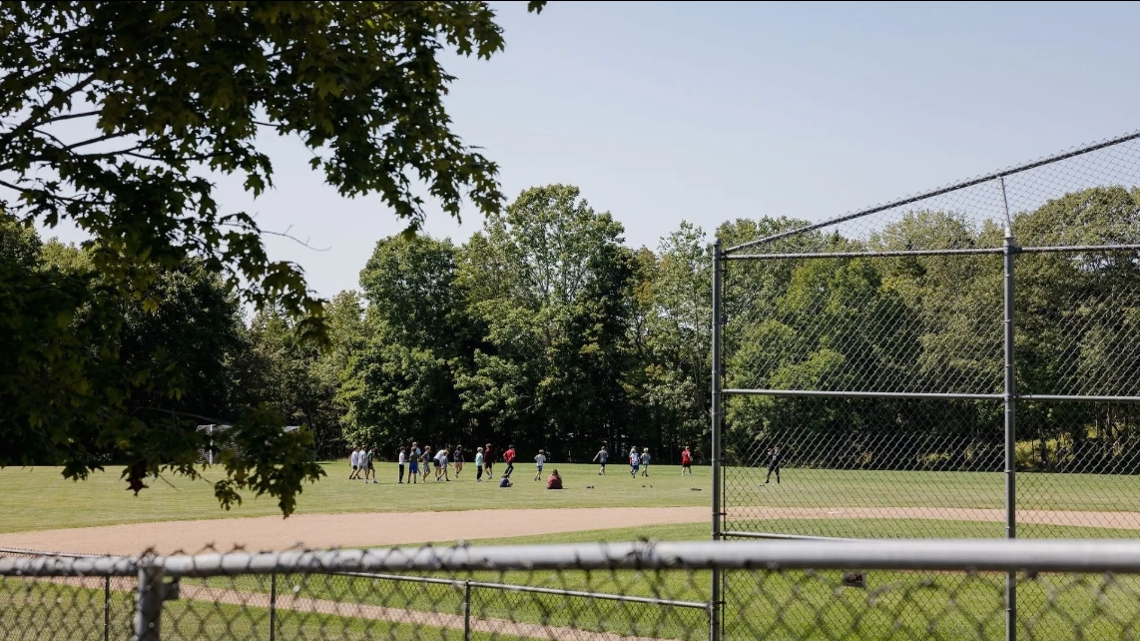
Opponents often ask why Mount Desert 365 can’t be more like another housing nonprofit, Island Housing Trust. The group has converted 49 homes — either purchased or acquired via donation — into workforce housing, said Marla O’Byrne, the Island Housing Trust executive director. It also built a workforce housing development of six single-family homes and two duplexes closer to the head of the island.
Island Housing Trust depends on donors, among them the conservative legal activist Leonard Leo, and the Law and Order television series creator Dick Wolf, as well as some of the Northeast Harbor residents suing the town.
The group has avoided the kind of controversy Mount Desert has found itself in with the Heel Way project. That’s because it has largely converted existing single-family homes into workforce housing, and has built in more remote parts of the island — away from the donor class.
“Those were not areas where the people that appealed this decision would necessarily even travel,” said Mount Desert town manager Durlin Lunt.
At one point, Mount Desert 365 proposed that Island Housing Trust take over the Heel Way Project. But Island Housing Trust turned down the offer, O’Byrne said.
“My board wanted to have more input into what was done, how it was done, and may have come to the same conclusions, but they didn’t just want to implement another organization’s project,” she said.
Some opposition is also connected to who is funding the project and what they plan next. Mount Desert 365 has other properties around town, and there is concern that all of them will be developed with a similar density.
“I’m going to address the elephant in the room,” said summer resident Betsy Kelly during a March 2023 planning board meeting, prefacing her comments by saying, as almost all opponents did, that she “fully supported the building of affordable housing in Northeast Harbor.”
“I’ve never seen a master plan from Mount Desert 365,” Kelly said. “The pockets are so deep, and the power and the control that MD 365 has is, or perceived to have, is very, very great.”
Opposition from the point
Several of the seven summer residents who sued to stop the project own summer homes down Smallidge Point Road, which begins a few hundred feet away from the Heel Way site, next to a sign that reads: “Private Road. Owners and Guests Only.”
The road is named after Smallidge Point, a small peninsula that forms the western shore of Gilpatrick Cove, ending near a private wooden bridge leading to the Northeast Harbor Fleet, the area’s yacht club.
Stuart Janney III, one of the plaintiffs, lives down this road and has summered in Northeast Harbor for most of his life. Janney is the chairman emeritus of Bessemer Trust, a private wealth management firm that oversees more than $200 billion, as well as a director of the New York Racing Association. Janney owned Orb, the 2013 Kentucky Derby winner.
He owns a summer residence assessed at $3.7 million that is located a quarter-mile from the Heel Way site. He and his wife have also donated tens of thousands to Island Housing Trust, according to the group’s annual reports.
In March 2023, Janney and his wife wrote to the planning board, explaining that Mount Desert 365 had invited them to an event in which the group laid out its plans. The dinner led the pair to conclude that the group’s approach was “ill conceived and not based on facts or analysis.”
“We were not alone,” they wrote.

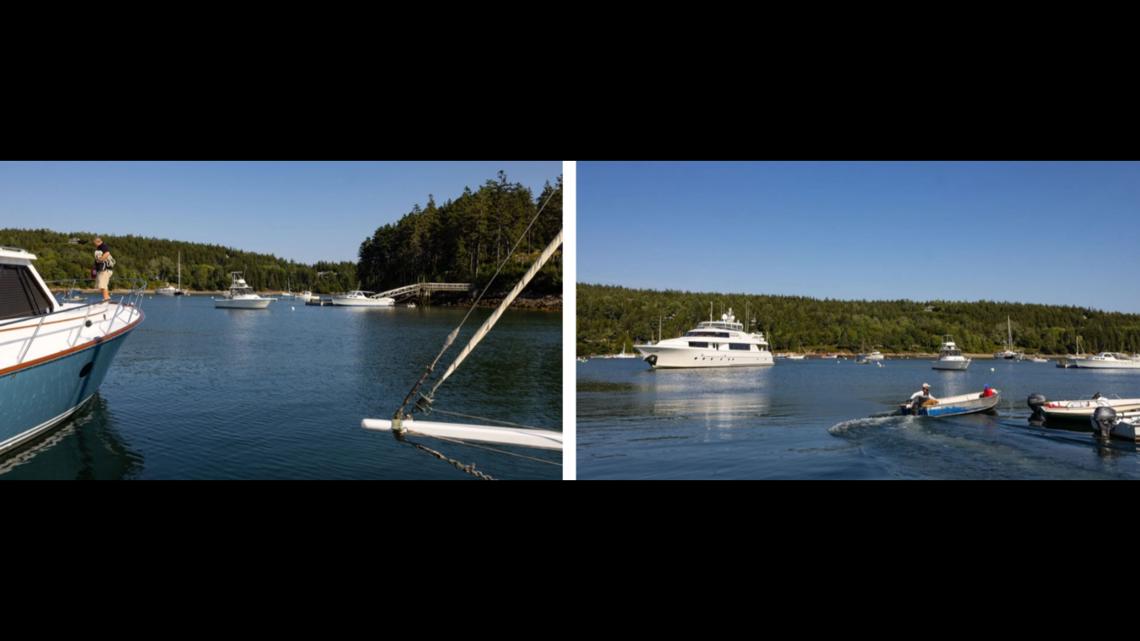
They said if the Heel Way project were developed “as proposed,” it would “have a profound negative impact on the neighborhood.”
They went on to say the group has “underperformed with past projects” and “has never stated a research-based case for what they propose.”
During a recent phone call, Janney declined to answer many of The Monitor’s questions on the record. But he stressed his desire for a vibrant year-round community.
“We all agree that we want the town to be more vibrant, to not have the lights out in the winter, to have a better workforce environment, to protect the school from going out of business,” Janney said.
“And I would also say that nobody in the community that I have anything to do with has ever had any problem or worry about the fact that we are a community of year-round residents and summer residents. We wouldn’t want it any other way. That’s what we grew up with. Some of my best friends are year-round residents.”
“Housing is a real need,” he added. “But the worst thing in the world for Northeast (Harbor) would have been for this project to go forward and have it be a complete failure.”
Lynne Wheat, another plaintiff, also owns property on Smallidge Point Road.
In October 2023, she wrote to Hanley to express concerns about “too many people and too many cars,” noting that “some child is going to get thrown off their bike, or worse.”
She said she feared the project would serve as a template for Mount Desert 365’s other properties, warning, “We won’t recognize our town in 10 years unless the ordinances are revised.”


Wheat’s Northeast Harbor home, which Decor Maine once called a “classic cottage,” is assessed at $5.2 million. Wheat owns the home, called “Mainstay,” with Allen D. Wheat, the former chief of Credit Suisse First Boston, who was fired in 2001 shortly before the firm agreed to pay $100 million to resolve a federal investigation into alleged abuses related to initial public offerings during the dotcom bubble.
Two other nearby parcels of Mount Desert property worth a combined $2.7 million and owned by separate LLCs have tax bills listed as “care of Lynne Wheat.” The tax bills for all these properties associated with Wheat are sent to a $96 million Palm Beach mansion owned by billionaire Thomas Peterffy. In 2018, Peterffy and Wheat made a donation to an auction for Friends of Acadia in the form of a dinner for 16 “at their new residence” in the tallest residential tower in the Western Hemisphere on Park Avenue in New York.
In an email, Lynn Wheat declined to comment.
Lamont Harris, a plaintiff whose great-grandfather Henry Flagler co-founded Standard Oil with John D. Rockefeller, also owns a property on Smallidge Point Road. Harris’ summer home is assessed at $4.2 million. He also owns a $5 million house in West Palm Beach, Fla.
He signed a letter, with several opponents and other plaintiffs, that said the project was “not consistent with neighboring homesteads” and “anyone driving around this project location can see that the homes in this section of Northeast Harbor have an abundance of acreage and open space around each single-family home.”
The Monitor was unable to contact Harris. Throughout the process, he has mostly let the group’s attorney, Grady Burns, do the talking.
“This proposed density is substantially larger than any comparable parcel in the area,” Burns said during a June 2023 planning board meeting. “These standards exist not just to make us feel good about the aesthetics of our neighborhoods, they are to protect the interests of property owners who have invested already in this community with the understanding that their neighborhoods, their communities, will change in a way that is measured, that is consistent with their expectations.”

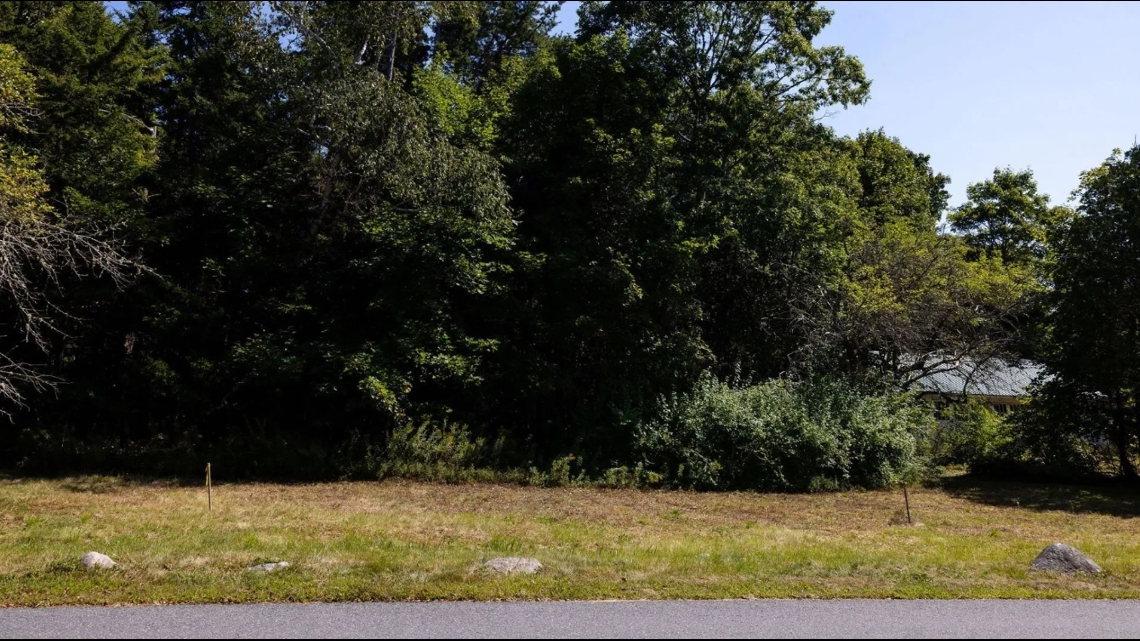
Marc Cannon and his wife Ann, both plaintiffs, bought a house in 2004 for $400,000 that sits about 100 yards from the project. It was recently assessed at $562,000.
“Everybody wants the town to prosper in the winter and everybody wants it to be successful, but you’ve got to be thoughtful about it,” Cannon said during a phone interview, adding that “the lot sat empty for four or five years and 365 didn’t even keep it up. They weren’t mowing the lawn. It looked terrible.” (Mount Desert 365 didn’t mow where the former residents had a vegetable garden, but the group did mow the lawn next to the house, Miller said, adding that she often did the mowing.)
Cannon declined to answer other questions on the record. Last year he retired from his position as chief customer experience officer for AutoNation Inc., a $6 billion publicly traded automotive retailer.
Cannon’s sister, Melissa Cannon Guzy, is also a plaintiff and owns a $1 million property close by. Guzy is the co-founder and managing partner of Arbor Ventures, a Singapore-based venture capital fund. She is also on Jackson Laboratory’s board of trustees.
The plaintiff who lives closest to the project site is Joseph T. Ryerson III.
Ryerson and his wife Barbara (who is not listed in the lawsuit but was involved in circulating the petition) own a home with a driveway that runs parallel to the lot’s property line.
Joseph T. Ryerson III is the great-great-grandson of Joseph T. Ryerson, whose company supplied steel to Ford when it began manufacturing cars. Today it’s traded on the New York Stock Exchange and worth more than $600 million. The Ryersons’ Northeast Harbor home is assessed at $842,500, and they also own a $1.1 million home in Massachusetts.
Ryerson has focused his opposition on the minutiae of the Heel Way project, emails sent to the planning board show, including questions about the capacity of the sewer line. In one email he noted the project could cause “a major disruption for present sewer easement holders, not to mention significant environmental damage to an area historically natural and unspoiled in appearance, enjoyed by present easement holders for walks, and being a pathway to and fro for deer, fox, felines, turkeys and others.”
The Ryersons declined to comment when a reporter knocked on their door last month.
‘Not a good look’
Nearby, in the driveway of a house directly across Manchester Road from the Heel Way project, Bill Newlin Jr. had a different take. Explaining that his parents owned the home (assessed at $3.2 million) and that his extended family has summered in the village for decades, he said his family had no problem with the project.
“We’re very cognizant of the need for affordable housing,” Newlin said. “What are we going to do, oppose it? That’s not a good look.”
Last year, Ned Herrington, a lifelong summer resident of Northeast Harbor who recently started at Stanford Law School, started a petition in support of the Heel Way subdivision after reading the petition against the development, which he thought “painted the summer residents in town in a terrible light.”
He wanted to show the planning board “that the summer residents weren’t a monolith.” The petition was signed by 225 people.
“I think these NIMBYs are operating against their own self-interest,” Herrington said. “They just don’t realize that if the winter community and the town suffer, that will cost them, too.”

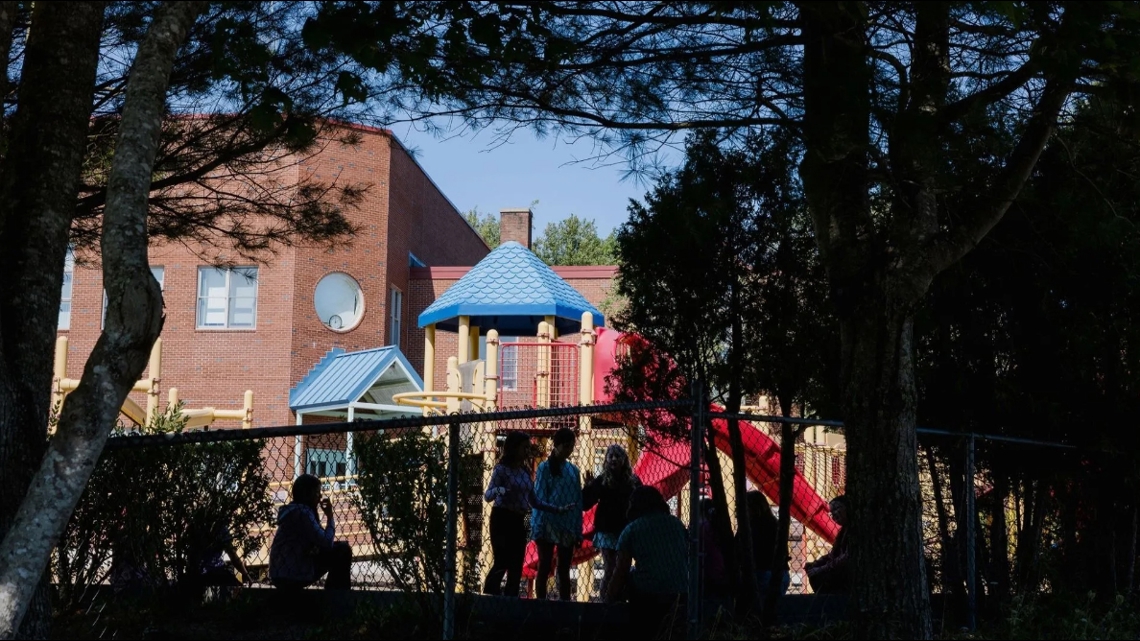
The town of Mount Desert has a unique dynamic, although one common to communities with seasonal residents who own expensive properties: Summer residents pay the lion’s share of the taxes, but because they are not year-round residents, they can’t vote.
Despite a 20 percent increase in the town’s total property valuation between 2022 and 2024, Mount Desert’s mill rate increased by about 15 percent in the same period. Meaning the town had to raise taxes even though it had more money coming into its coffers.
“You have to pay a higher premium for wages to convince people and make it worth their while to come down,” said Lunt, the town manager. “So the property values go up, also the costs of the government go up.”
In 2021, the local nonprofit Northeast Harbor Ambulance Service notified the town of Mount Desert that it couldn’t continue to operate. The town’s dwindling year-round population had made recruiting enough volunteers impossible.
So the town took over ambulance and EMS duties in 2022. It expanded the fire department, enlarging its roster from four to 14 employees, renovated one fire station and rebuilt another, adding quarters, bunks and day rooms. The final price for the facilities was around $6 million.
Responsibility for building out this new organization fell to the fire chief, Michael Bender. He had to hire a dozen or so new staff members, but hasn’t been able to fill the last paramedic position. They’ve advertised the job nationally for two years, Bender said, but have had no luck, despite paying some of the highest wages in the state.
“When people start looking at and researching the housing here, they realize they can’t afford to live here,” he said.


About half of the department’s staff live on the island; the other half come from farther away. One drives in from Old Town, north of Bangor. It’s about a 55-mile drive each way, taking nearly three hours round-trip.
Even caretakers who look after seasonal properties while owners are away seem to be moving off the island, Bender said.
It used to be that if the department responded to a fire alarm in the middle of the night during the off-season, they could find someone nearby who had a key to the residence.
Now, he said, “sometimes we’re waiting half an hour for somebody to come from off island.”
Holding out hope
As the lawsuit awaits a decision from Maine’s high court, change is happening at Mount Desert 365. In the spring, the Rales brothers resigned from the group’s board.
New board president Rick Savage — a lifelong Northeast Harbor resident, chair of the Mount Desert harbor committee and owner of a chartered boat tour company — supported the Heel Way project in communications with the planning board before joining the organization.
For now, he said, Mount Desert 365 is putting the Heel Way project “on the back burner.”
He wants the organization to pivot to a “much smaller” project on one of its other nearby properties on Summit Road, which would likely be a duplex, as a sort of proof-of-concept.
Mount Desert 365 has also met with some plaintiffs, who “offered to drop the lawsuit if we would make concessions,” Savage said. “I don’t think the board is in a position to make any concessions.”
But the group is in the process of assembling an advisory board, and is considering some of the plaintiffs as potential members.


As for the Rales brothers, they took a step back because they had become a lightning rod for criticism, Miller said.
“They are a big target,” Miller said, “so they stepped down so that we would succeed.”
The plaintiffs seem to feel their efforts have been successful.
“The situation has been difficult,” Janney said, “but I think we’re in a far better place today than we were.”
Cannon said Mount Desert 365 has a “whole bunch of new board members who have now opened the door to wanting to talk to us.”
“I think we’re going to get a compromise,” he said. “We’ve even offered money to help the organization.”
Meanwhile, the summer season is winding down. Kids are back in school, and visitors are limited to what some in the local restaurant business call “newlyweds and nearly deads” — tourists on either side of their child-raising years. By the end of October, the stores will close up and the multi-million-dollar yachts will leave for warmer climes.

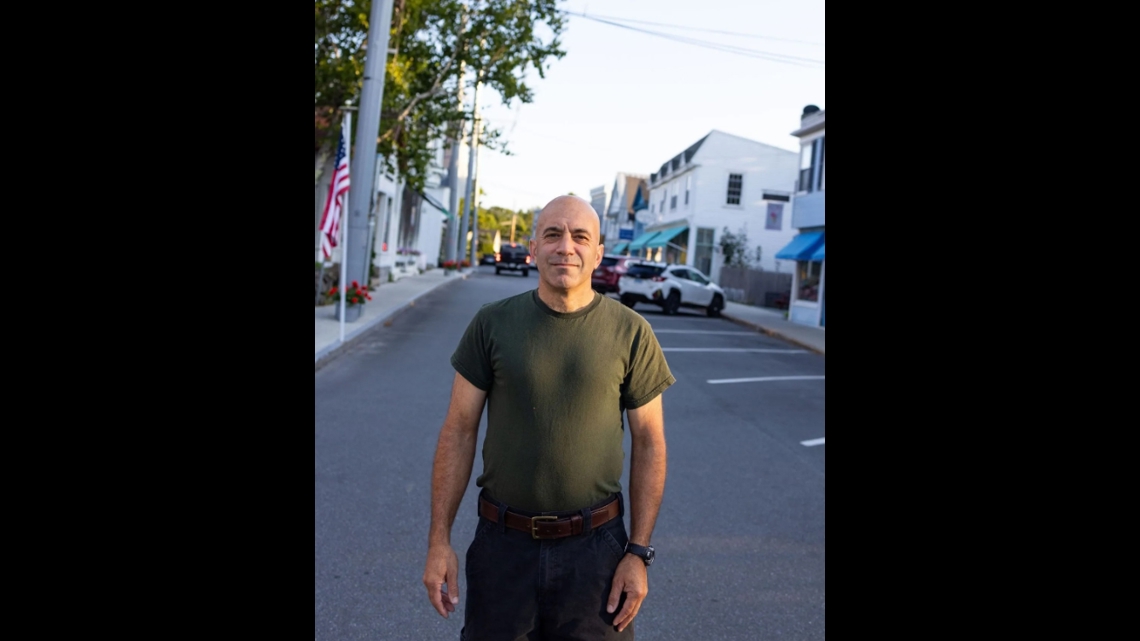
Anastasia, the Acadia maintenance worker, is holding out hope for the project despite opponents’ fears.
“It’s not reality that they’re fearful of,” he said. “It’s not a justifiable set of things that are legitimate concerns.”
It’s not just that the bad things predicted by the naysayers won’t happen, Anastasia explained. It’s that good things would happen.
Should the Heel Way project succeed, he said, the community would be enriched by more year-round residents taking an interest in their surroundings and their neighbors: “It’s year-round housing for year-round people who call this place home.”
He said he often walks by the Heel Way property in the winter. He can see the houses of the neighbors, some of whom have gone to great lengths to stop the project. The lights are always off, their houses cold and dark.
“They’re all empty,” he said.
This story was originally published by The Maine Monitor, a nonprofit and nonpartisan news organization. To get regular coverage from the Monitor, sign up for a free Monitor newsletter here.


